‘Vision’ means the ability to see. This includes being able to see close up and in the distance.
Distance vision
Distance vision is the ability to see objects clearly from a distance.
Distance vision is used to see (for example):
- The blackboard in a classroom
- Street or shop signs
- Faces across a room
Near vision
Near vision is the ability to see objects close up.
Near vision is used for tasks such as:
- Reading books or newspapers
- Sewing
- Preparing food
- Sorting objects
Vision problems
There are different problems that a person may have with their vision including:
- Eye health problems
- Distance vision impairment
- Near vision impairment
Most vision problems are avoidable with prevention, the right treatment, and/or assistive products. For example:
- A person with a cataract can have surgery that restores their vision.
- A person with a distance vision impairment may have full vision with prescription glasses.
Some vision problems however are unavoidable. This means treatment will not fully restore vision. However assistive products and a more accessible environment can assist the person to do the things they need to do.
Consent for use of information
Please let us know if you give consent for information collected during this training to be used for future reporting and research activities.
Check yes or no to each question below. If you select no, you are still very welcome to continue the training.
2. I understand that my de-identified information collected during this training (including this registration form, online feedback survey, quiz results and discussion forum) will be used in reporting and research to help improve TAP and improve access to assistive technology, and I give my consent for this.
Page
of
Show / Hide lesson topics
Page
Previous page
Next page
Show / hide menu
completed
not completed
in progress
not started
Expand All
Collapse All
module lessons
Search results pagination
Login
Username or email address
Password
Lost password
Main content anchor
Search
Close search
Lesson navigation
breadcrumb
Module menu
Topic navigation
See all
Menu
Site menu
User account related
Group secondary navigation
opens in a new tab/window

